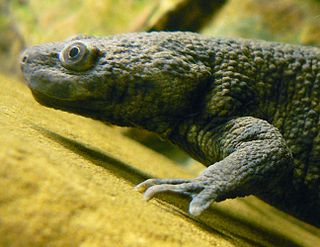
Salamandridae is a family of salamanders consisting of true salamanders and newts. Salamandrids are distinguished from other salamanders by the lack of rib or costal grooves along the sides of their bodies and by their rough skin. Their skin is very granular because of the number of poison glands. They also lack nasolabial grooves. Most species of Salamandridae have moveable eyelids but lack lacrimal glands.

The Iberian ribbed newt, gallipato or Spanish ribbed newt is a newt endemic to the central and southern Iberian Peninsula and Morocco. It is the largest European newt species and it is also known for its sharp ribs which can puncture through its sides, and as such is also called the sharp-ribbed newt.

Tylototriton verrucosus is a species of newt found in the Indian subcontinent and Southeast Asia. Common names include: Himalayan newt, crocodile newt, crocodile salamander, Himalayan salamander, red knobby newt.

Pleurodeles is a genus of three species, the ribbed newts:

The Chuxiong fire-bellied newt is a species of salamander in the family Salamandridae that is endemic to China where it is only found in Guizhou and Yunnan. It also occurs in Kunming Lake.

Anderson's crocodile newt, Anderson's newt, Ryukyu spiny newt, or Japanese warty newt is a species of salamander in the family Salamandridae found in the Ryukyu Islands of Japan, and, at least formerly, Mount Guanyin in northern Taiwan, where it is now believed to be extinct.
The Chinhai spiny newt is a species of salamander in the family Salamandridae, found only in a small section of Zhejiang province in eastern China. Its natural habitats are temperate forests, freshwater marshes, and ponds.

The Pyrenean brook salamander or Pyrenean newt, , is a largely aquatic species of salamander in the family Salamandridae. It is found in the Pyrenees of Andorra, France, and Spain. The IUCN lists it as least concern.

Paramesotriton, also known as warty newts or Asian warty newts, is a genus of salamanders in the family Salamandridae. The genus is found in southwestern and southern China and in northern Vietnam. Most of the species are endemic to China, and the majority of them have been described recently, since 2008. The genus includes both pond and stream dwellers.

Pleurodeles poireti, the Edough ribbed newt or Poiret's newt, is a species of salamander in the family Salamandridae. It is found only in the Edough Massif, in the north east of Algeria.

The Italian newt is a species of salamander in the family Salamandridae found only in Italy. The species can be found in temperate forests, temperate shrubland, Mediterranean-type shrubby vegetation, freshwater lakes, intermittent freshwater lakes, freshwater marshes, intermittent freshwater marshes, arable land, pastureland, rural gardens, water storage areas, ponds, and canals and ditches. It is threatened by habitat loss, natural land conversion and invasive species. It was formerly known as Triturus italicus, but was relocated to the genus Lissotriton after Triturus was split.

The Carpathian newt, or Montandon’s newt, is a species of salamander in the family Salamandridae found in Czech Republic, Poland, Romania, Slovakia, and Ukraine.

The southern marbled newt or pygmy marbled newt is a species of salamander in the family Salamandridae. It is found in Portugal and Spain. Its natural habitats are temperate forests, Mediterranean-type shrubby vegetation, rivers, intermittent rivers, freshwater marshes, intermittent freshwater marshes, arable land, pastureland, rural gardens, water storage areas, ponds, open excavations, irrigated land, canals and ditches. It is threatened by habitat loss.

The black knobby newt is a species of salamanders in the family Salamandridae found in China and Vietnam. Its natural habitats are subtropical or tropical moist lowland forests, subtropical or tropical moist montane forests, freshwater marshes, and intermittent freshwater marshes. It is threatened by habitat loss and overharvesting.

Barbarophryne is a genus of toads in the family Bufonidae. It is monotypic, containing only the species Brongersma's toad, also known as Tiznit toad. It is found in Algeria and Morocco. It is a small toad, up to about 5 cm (2 in) in snout–to–vent length.

The Betic midwife toad or Sapo Partero Bético is a species of frog in the family Alytidae. It is endemic to mountainous in south eastern Spain. Its natural habitats are temperate forests, freshwater marshes, intermittent freshwater marshes, pastureland, ponds, and aquaculture ponds. It is threatened by habitat loss.

A newt is a salamander in the subfamily Pleurodelinae. The terrestrial juvenile phase is called an eft. Unlike other members of the family Salamandridae, newts are semiaquatic, alternating between aquatic and terrestrial habitats. Not all aquatic salamanders are considered newts, however. More than 100 known species of newts are found in North America, Europe, North Africa and Asia. Newts metamorphose through three distinct developmental life stages: aquatic larva, terrestrial juvenile (eft), and adult. Adult newts have lizard-like bodies and return to the water every year to breed, otherwise living in humid, cover-rich land habitats.

There are 14 species of amphibians and 5 species of reptiles known to occur in Mount Rainier National Park.

The Montseny brook newt is a species of salamander in the family Salamandridae. It is endemic to the Montseny Massif in northeast Spain. Before it was formally described in 2005, it was mixed with the larger and more widely distributed Pyrenean brook salamander.




















